Introduction, Scope and Scale
Music Museum exhibits a range of various musical instruments, which represent numerous cultures and historical periods for the visitors to increase their knowledge and enjoy.
Generally, museums are classified into two main categories according to:
- content
- purpose
The majority of the tourists, who come to see the city, visit its museums. It has a positive impact on the profit, allowing to have a revenue of about 5million dollars per year (MIM annual report, 2015). There should be about 80 employees in total.
We can observe “national museums, college and school museums, professional or class museums, museums or cabinets for special research owned by societies or individuals” (Conn, 2009). Today there are more than 50 types of museums depending on their exhibit items, such as aviation, ceramics, food, and musical instruments, of course.
Including the citizens, the musical museum can gather several thousands of people each year.
The guides are to have music education to explain and show the visitors how the instruments work.
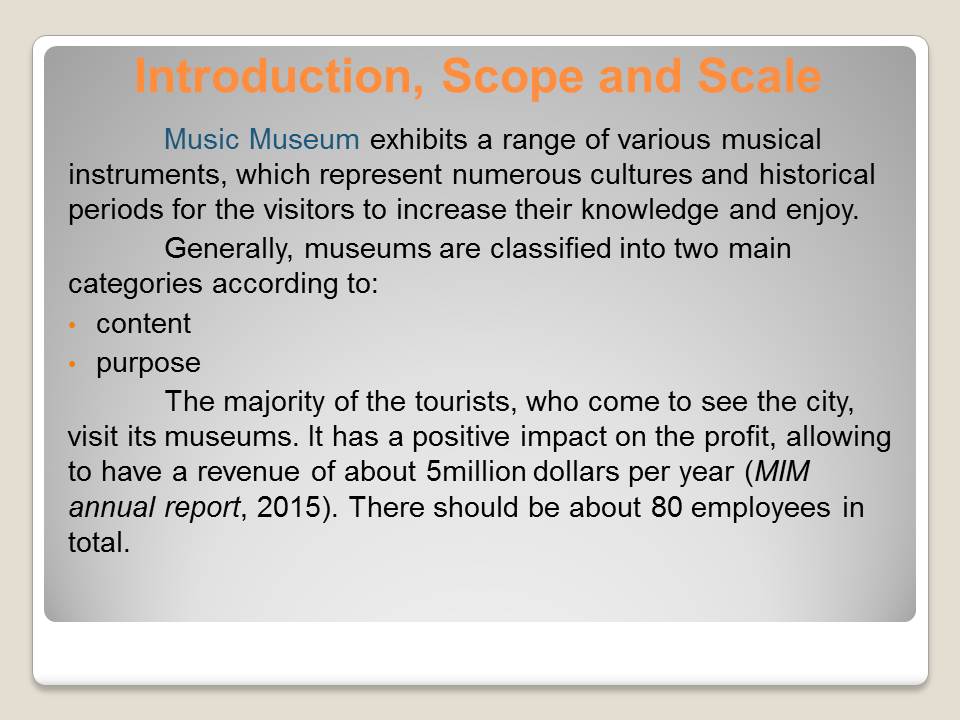
Public Partnership
- Music Museum is a nonprofit organization. It operates within the public sector and, to maintain the exhibitions; it receives financial support from donators.
- The basic international laws regulating museum activity are rather numerous.
Of course, the museum receives money from the visitors, but the cost of the tickets is not high.
The donators are individuals and private sources as well as public ones. For example, wealthy individuals (including politics and musicians) and the Phoenix Office of Arts & Culture.
The legislation includes “the regulatory instruments of the UN, UNESCO, European community, a number of global, international and European organizations concerning related fields of activities, international intergovernmental and bilateral agreements, and already enacted laws and draft laws of the CIS member states” (Andreeva & Gnedovsky, 2014).
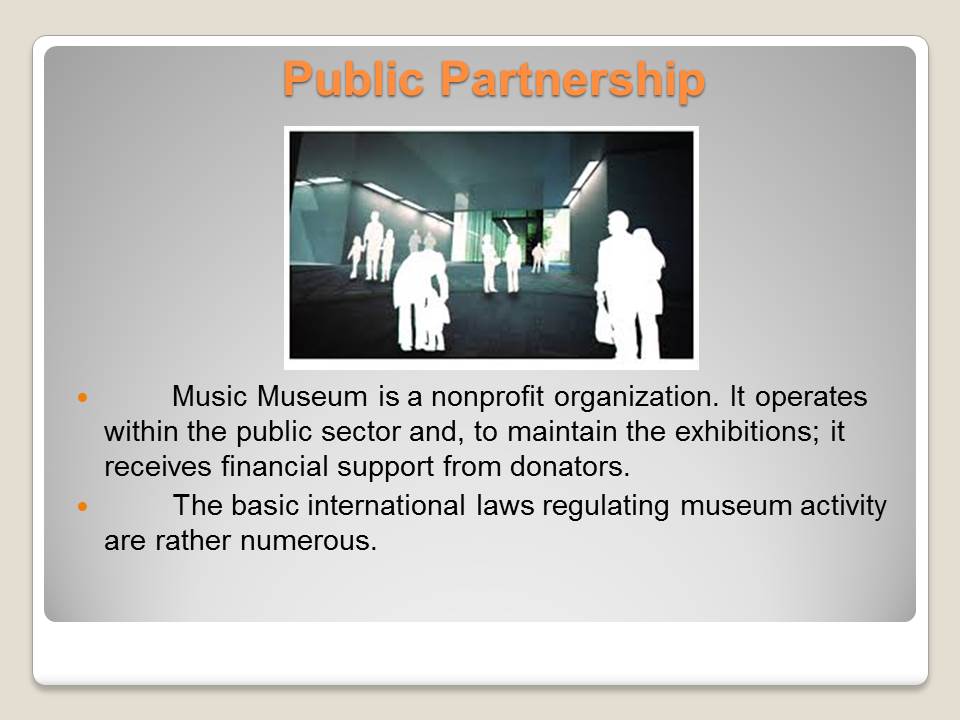
Market and Segmentation
The location of the Musical Museum is Phoenix.
23.8 million visitors arrived in Arizona in 2012, and more than 20% of them traveled for leisure (Tourism facts, 2013).
To serve the population, no F&B is needed.
The most common visitors are likely to be local residents and those who live in Arizona. Still, the domestic population often loses interest to the attractions that they can see very often. It means that in a year after the opening, only individuals who enjoy music and history come. However, by this time the museum attracts tourists from all over the world. It means that the majority are likely to come to the Musical Museum.
As the museum adds new items to the exhibition, people often come several times. To please the consumers, it provides music lessons and organizes concerts.
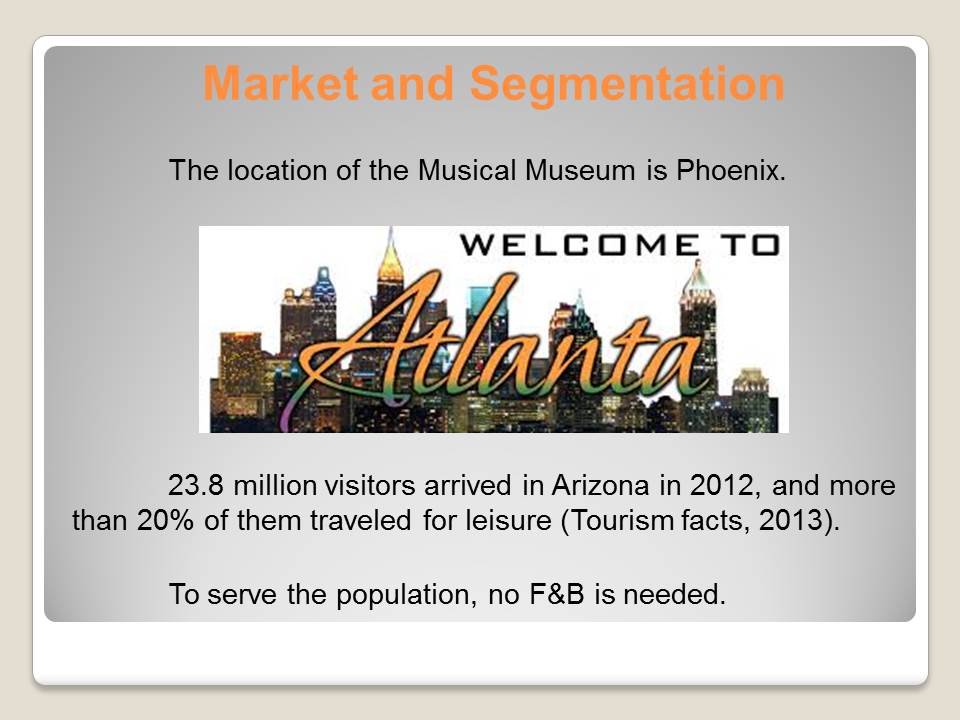
Attraction lifecycle/development
- The visitors brought 4,972,256 dollars in 2014 to the museum (MIM annual report, 2015).
- To increase the income and attract more visitors, the Musical Museum organizes concerts that are attended by almost 50 thousand individuals.
- People who are inspired by music can take part in various programs.
- Once per year, the festivals are held.
- New items for exhibitions are mostly brought by the sponsors and bought by the museum.
The average ticket price is 15 dollars. More money is gained due to the contributions and sponsors.
The representatives of different nations are invited to make the museum popular on the global arena. It is targeted at children also and welcomes more than 600 school groups.
There are some for kids (K-12 students and elder), families (with children aged 0-5 and 6-10) and even educators.
All these events are supported by volunteers.
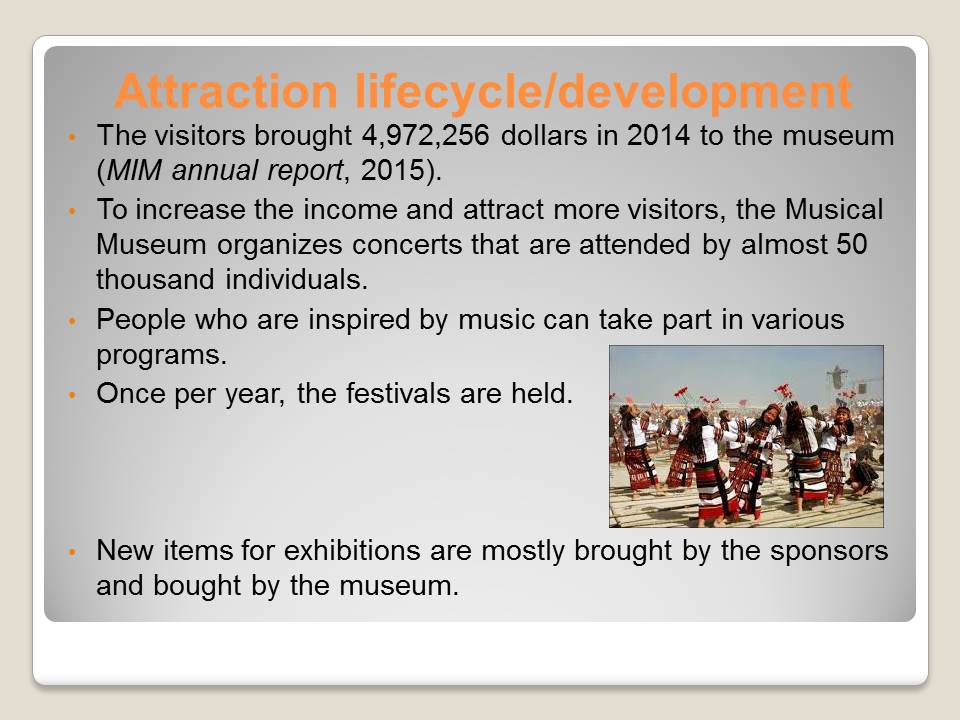
Core Attraction and Offer
The success of the Music Museum depends on:
- Organization strategy;
- Personnel performance;
- Design;
- Special offers.
The most frequent problem faced by the museum:
- Collection;
- Restoration;
- Sound;
- Selection;
- Personnel.
The success of the Music Museum depends on its organization. It attracts many people and makes them come several times in regard to the customer-oriented strategy. The personnel is always friendly, and the guides ready to interact with the visitors. The exhibition items are unique and are located so that the interior looks unusual and visitable. Special programs provided by the museum also enhance its success.
The most frequent problem faced by the museum is gathering the collection. The instruments often need restoration, during which they might be damaged or become visually different. Moreover, if the instrument does not produce the sound anymore, it occurs to be less attractive to the visitor. In some cases, it is hard to select those that can be still used. One more issue is finding the personnel with appropriate musical education (Oey, 2006).
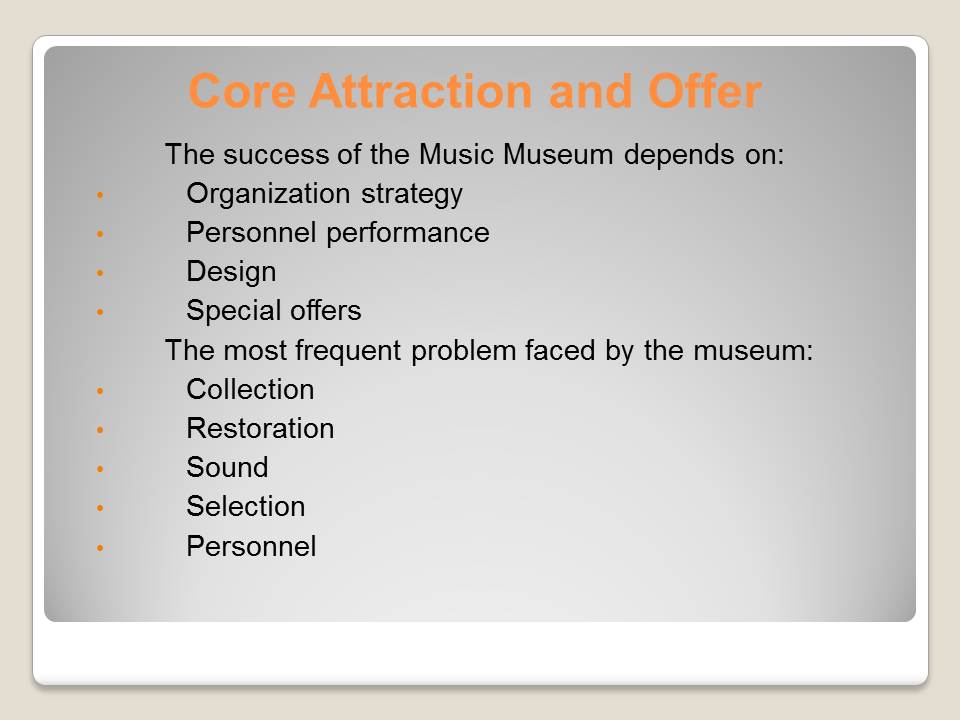
Theming and Interpretation
Needless to say that the exhibitions at the Music Museum are always connected with the theme of music. Still, to make the display more attractive and organized, the items are selected within a tighter framework:
- Genre of music;
- Person/band;
- Location;
- Period of time;
- Type.
The examples include the instruments, images, and photos that refer to the popular culture. It may also be the exhibition “Women who rock”, which lets people learn some facts about the singers and musician, see their costumes, CDs, etc. (EMP museum, 2013).
One more way to organize the items is to select only those that refer to a particular person or band. Except for that, the instruments can be divided according to their types: “the strings, the wind, brass, and the percussion” (Gazard, 2013). Moreover, the exhibition can include the instruments that belong to the particular period of time and be modern or more than a century old.
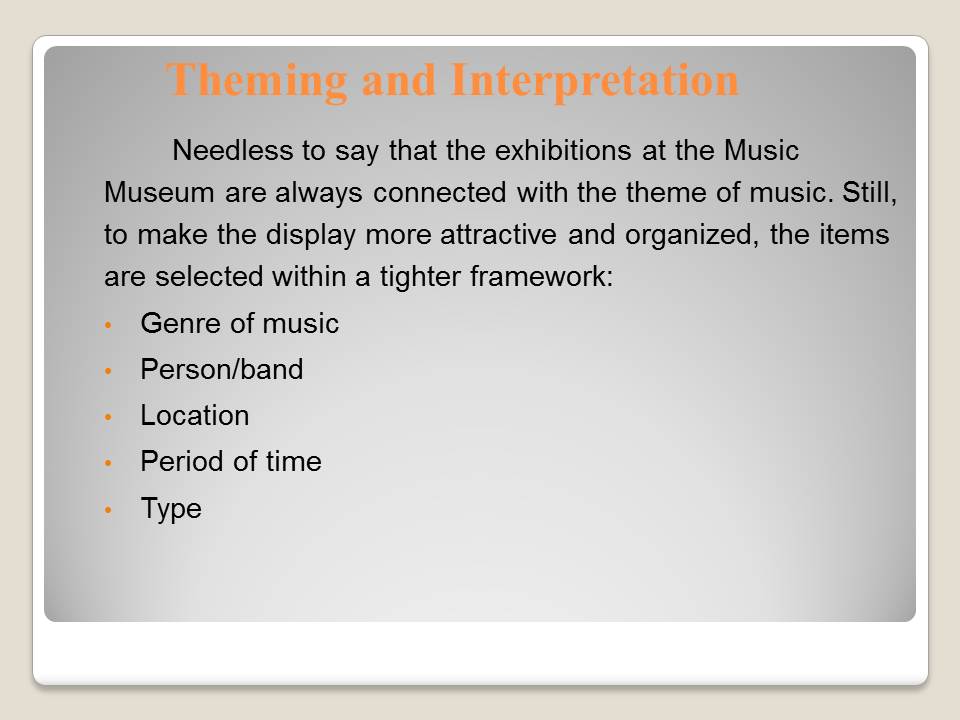
Hospitality and Event Provision
Depending on the exhibition, the variety of needed services differs. They may need:
- Teachers;
- Instruments;
- Rooms;
- F&B;
- Security;
- Design.
The programs that are maintained by the museum and are made for children need to be held not only by the guides but by the teachers of music. The organization is to supply everybody with the instrument and furnish a room, where a group can work (MIM annual report, 2015). For the concerts, a green room is needed as well as some food or restaurant service (depending on the demands).
People who are performing can ask for the security or interpreter. Common exhibitions do not need extra provision, except for a checkroom in winter. Due to the location, special transportation may be needed. The design also depends on the items that are selected for temporary exhibitions to make the environment look more authentic (bright colors, photos with stars for pop exhibition).
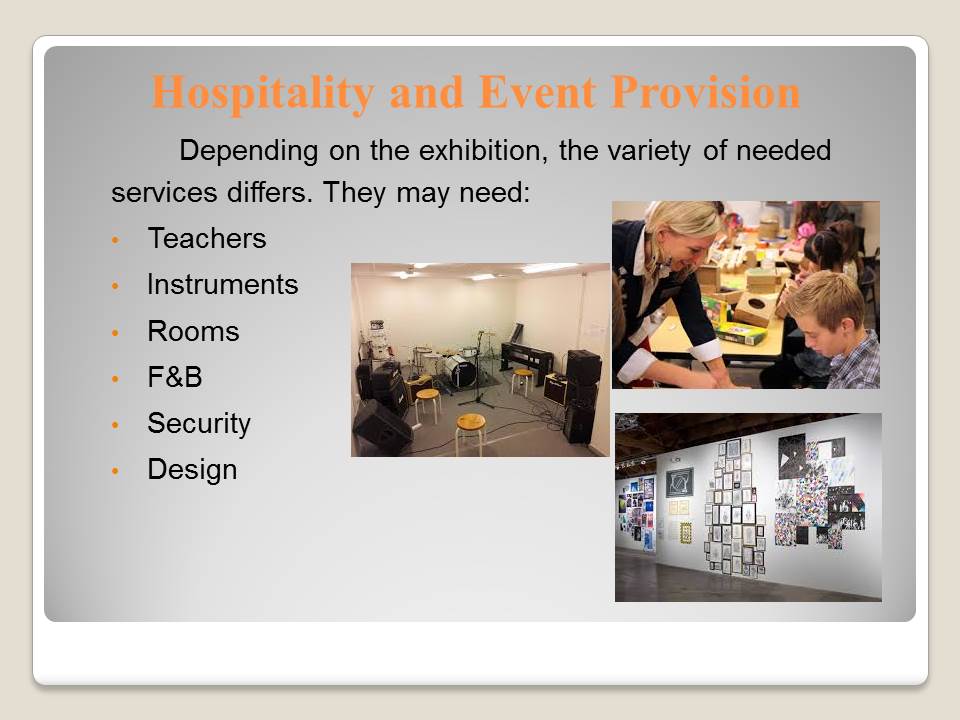
Key Points for Potential Recruits
The future event managers should rely on the experience of other museums to maintain all operation successfully:
- Interesting themes;
- Design peculiarities;
- Location of the items;
- Ticketing.
New displays attract the visitors if they deal with themes interesting for the general public. The director of the Music Instrument Museum underlines Johnny Cash, Italian violin makers, and African art objects. For them to look appropriate, the general design is to be neutral while the section with the instruments is to be organized creatively.
The items that seem to be usual but are hinged to the ceiling occurred to capture the eyes of the visitors. An extraordinary location is easy to manage and is beneficial. Ticketing is also to be considered. There should be different prize for adults and children. It is good to allow kids aged 0-3 enter for free, as then more parents come.
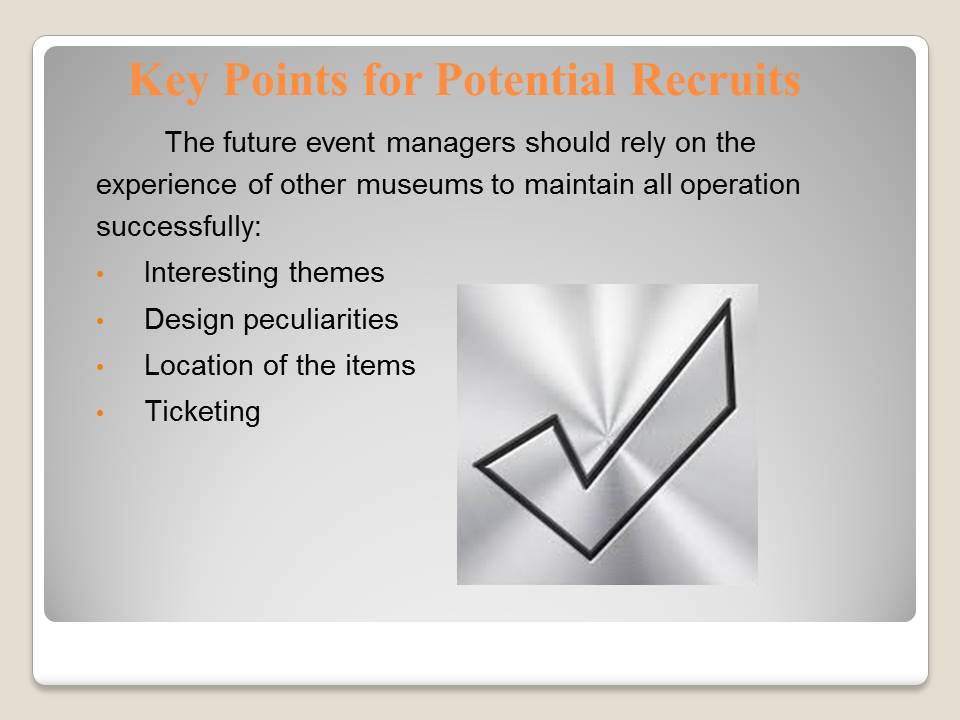
References
Andreeva, G., & Gnedovsky, A. (2014). Development of museum legislation. Web.
Conn, S. (2010). Do museums still need objects? Philadelphia, PA: University of Pennsylvania Press.
EMP museum. (2013). Web.
Gazard, P. (2013). Howtocreate a successfulmusicensemble. New York, NY: Music Sales Group.
Oey, M. (2006). Some problems in musical instrument conservation in museum collections. Web.
Tourismfacts. (2013). Web.